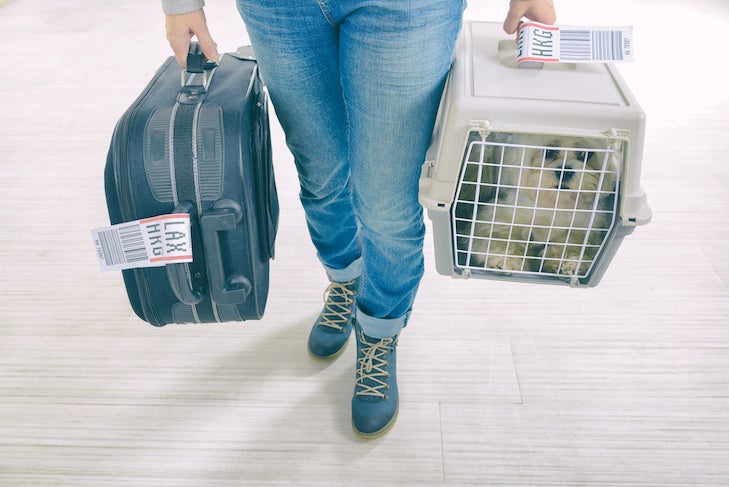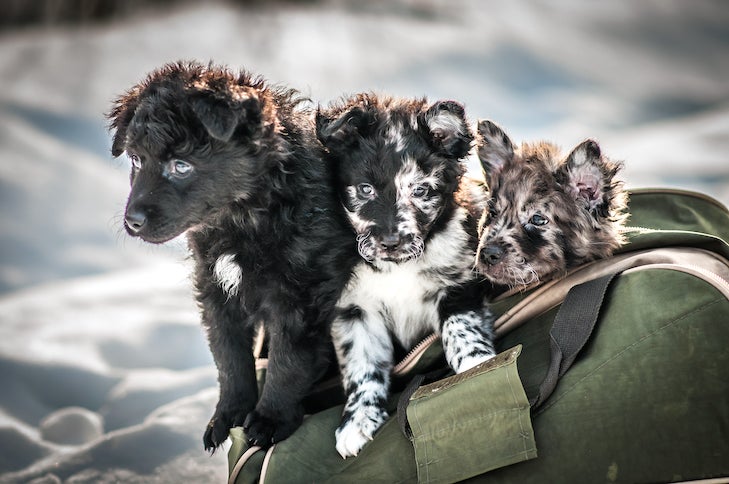AKC is a participant in affiliate advertising programs designed to provide a means for sites to earn advertising fees by advertising and linking to akc.org. If you purchase a product through this article, we may receive a portion of the sale.
When I decided to add a Lagotto Romagnolo puppy to my household, I searched for a responsible, knowledgeable breeder I thought would breed the qualities I wanted in my new dog. When I found my breeder, I didn’t let the fact that she was in the Midwest stop me from applying to be on her puppy waiting list, even though I live in the Mid-Atlantic.
Families wanting to welcome a new puppy into their lives have more options than ever for connecting with the perfect pet. If you’ve found that special new furry family member a few states away, here are some suggestions to help you make sure your puppy has a safe and comfortable first flight.
Find Out What You Need for the Flight
As soon as my puppy was born, I started making plans to fly to the Midwest and bring her home. But before making any airplane reservations, it’s important to check with your airline to determine if they will fly a puppy. Some airlines have pet restrictions on dog age, size, and breed type, as well as what type of travel crate is required.

If you plan to have the puppy travel with you in the airplane cabin, you’ll need to have that noted on the airline reservation. Most airlines limit the number of animals allowed in the cabin at one time, so make your reservation as far in advance as possible.
Only small dogs and cats that can fit in airline-approved pet carriers under the seat are allowed in the cabin. There’s usually a fee of $100-$150 in addition to the cost of your ticket, and approved carriers cost $30 and up. Some airlines may not allow dogs in the cabin at all and will transport them as cargo in a heated and ventilated hold. Learn about specific dog airline travel guidelines before you go.
If the puppy is shipped as cargo, you need to take weather and time of year into account as you plan for the puppy’s travel, which may be affected by extremely warm or cold temperatures. The Centers for Disease Control and Prevention reports that some U.S. carriers don’t allow pets to be shipped between May and September, the hottest months, if they’re being transported as cargo.
Be Sure the Puppy Is Old Enough to Fly
Puppies must be at least eight weeks old and have been weaned for at least five days for air travel, according to the U.S. Department of Transportation. If it’s a small breed dog, there may be weight and age minimums, too.
The CDC requires all dogs entering the United States to be immunized against rabies. So, if your puppy is being imported to you from outside the U.S.A., be sure you’ve done the math on vaccines. Puppies should get puppy vaccinations at least one month prior to traveling, and rabies vaccines are not given before a puppy is three months old. In other words, dogs entering the U.S. on international flights must be at least 16 weeks old.

Make a Visit to the Vet Before Puppies Fly
A puppy must be healthy enough to travel, so a visit to the veterinarian is essential. Some airlines require a veterinary health certificate to be issued within a specific number of days before travel.
Puppy deworming should be completed at least three days before the puppy is scheduled to fly. Puppies can’t be accepted for travel if they have any signs of recent surgeries, so make sure they’re completely healed from any procedures they may have had.
Whether you’re traveling with your puppy from state to state or internationally, there will be health requirements you have to meet that will vary by your origin and destination.
Prepare the Puppy for Flying
To help your puppy relax on the flight, it’s a good idea to order the travel crate that meets the airline’s requirements ahead and have it delivered to the breeder. The breeder can put the puppy into the carrier for naptime and place it under a desk or table to help the puppy get used to it.
Offering the puppy treats or feeding them in the carrier may also give puppies a positive association with their travel carrier. Ask the breeder to give you a blanket or soft toy that smells like the mother and littermates to accompany your puppy inside their travel crate.
Plan for the Unique Needs of the Puppy’s Breed
Since dogs come in all shapes and sizes, air travel might be easier for some breeds than others. Large-breed puppies, for example, will need a bigger, sturdier crate than small-breed puppies. The pet carrier must fit under the seat in front of you, and most airlines require that the puppy weigh less than 25 pounds and be able to stand up in the crate, turn around, and lie down.
If you’re traveling with a brachycephalic (or short-muzzled) breed puppy, it’s especially important to have a well-ventilated crate and plenty of air flow. “These breeds can run into respiratory challenges in increased temperature or humidity. Confinement in a carrier could exacerbate these conditions,” notes AKC Chief Veterinarian Dr. Jerry Klein.
Check with your airline to confirm specific requirements for puppy breed, age, and size.

How to Handle Flight Day With Your Puppy
A puppy shouldn’t be fed solid puppy food for about four hours before a flight, but it’s OK to offer water and time outside to exercise and eliminate. Place several layers of puppy pee pads inside the travel crate and carry extras to add to the crate or use at the airport.
If you’re traveling with a puppy in the cabin, most airlines require you to sign in at the passenger check-in desk and show any required paperwork, such as your flight reservation and the puppy’s health certificate.
If you have a young puppy who hasn’t received their full series of puppy shots, it’s best to carry them around the airport and stay away from designated dog elimination areas. You can take your puppy outside or to a low-traffic area of the airport, put them on a pee pad, and give him a chance to go.
The Federal Aviation Administration considers the pet travel crate to be carry-on luggage, and it must be put through the carry-on luggage screening device – but your puppy does not have to go through. When you go through security, carry your puppy in your arms and take them through the human screening process. If possible, don’t check any luggage, so you can leave the airport immediately when you arrive. Use a backpack to keep your hands free for the puppy. Travel as light as possible with your personal luggage so you can focus on your puppy’s needs and supplies for this trip.
What to Take on Puppy’s Flight Travel Day
Some absolute essentials, like an airline-approved carrier or water bowl, and some good ideas, like grooming wipes and a change of clothes.
- Airline-approved travel carrier or hard-sided dog kennel that meets federal and/or any specific airline requirements
- Leash suitable for your puppy
- Harness suitable for your puppy
- Collar suitable for your puppy
- ID tag for your puppy
- ID tag and “live animal” stickers for your travel crate
- Puppy health records
- Airline reservation verification and pet fee receipt
- Puppy pee pads
- Poop bags (in case you or your puppy can’t get to a pad in time)
- Puppy-safe grooming wipes (for feet, or puppy coat clean-up in case of any accidents)
- Travel-sized packages of disinfecting wipes, paper towels, trash bags (to spot-clean floors, clean up an accident, and throw supplies away neatly)
- Travel bowl for water
- Bottled water or access to water at the airport
- Puppy food in case of layovers, stored in an air-tight pet food travel container or resealable zippered plastic bag
- Puppy-safe treats
- Puppy-safe toys (Puppy chew toys to keep them occupied are a good choice, or soft puppy toys to keep them company, but no squeaky puppy toys to annoy other passengers; save the squeakers for home.)
- Change of clothes for yourself in case your pup has an accident
Our Lagotto puppy was a superstar in the airport. So many people stopped to ask what breed she was and to pet her, which can offer great puppy socialization opportunities. On the plane, she slept quietly in her crate. I’ve never had more fun flying!


